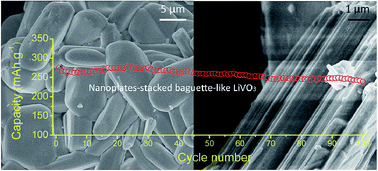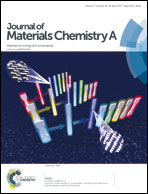Nanoplate-stacked baguette-like LiVO3 as a high performance cathode material for lithium-ion batteries†
Abstract
LiVO3 has been proposed as an appealing cathode material to substitute traditional capacity-limited cathodes for high energy lithium-ion batteries. However, just like other Li–V–O compounds, the application of the LiVO3 cathode is restricted by its poor cycling stability and rate capability. In this paper, we report, for the first time, nanoplate-stacked baguette-like LiVO3 by an in situ template method. In this unique structure, the micro-sized baguette shape can help to inhibit the dissolution of vanadium in comparison with nanosized LiVO3, and the stacked nanoplates can provide short diffusion pathways for lithium ions. Benefiting from these advantages, this material can deliver a very high capacity of 275.6 mA h g−1 with excellent cycling stability, Moreover, a capacity of 156.1 mA h g−1 can be obtained up to 4 C (1200 mA g−1). The exceptional electrochemical performance suggests the use of nanoplate-stacked baguette-like LiVO3 as an alternative cathode material for high-energy lithium-ion batteries. Particularly, the synthesis strategy demonstrated herein may be extended to fabricate other types of multifunctional vanadium-based compounds for energy storage.


 Please wait while we load your content...
Please wait while we load your content...